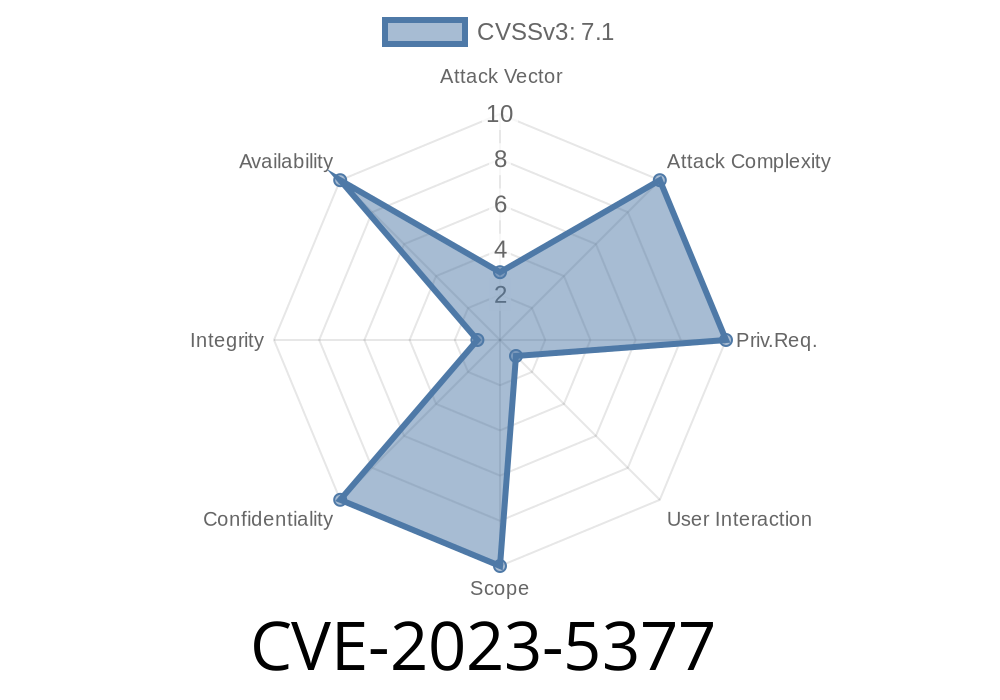Overview
A recent major vulnerability has been discovered in the GitHub repository gpac/gpac, affecting versions prior to v2.2.2-DEV. Dubbed CVE-2023-5377, this out-of-bounds read flaw can lead to potential security risks, allowing attackers to access sensitive data or ultimately causing application crashes. In this post, we'll explore the details of this vulnerability and how you can address this issue in your own projects.
The Vulnerability
CVE-2023-5377 is classified as an out-of-bounds read vulnerability, which means that an attacker can read data beyond the boundaries of an allocated memory buffer. This can lead to information leaks or application crashes due to accessing invalid memory addresses.
This particular vulnerability lies in the gpac repository, which is an open-source project designed to provide multimedia processing and streaming capabilities. By exploiting this vulnerability, attackers can potentially gain access to sensitive information stored in memory, including keys and passwords.
Here is a code snippet demonstrating the issue within the affected gpac project
/* Faulty code */
int index = ;
unsigned char *data_ptr = data_buffer;
while (index < data_buffer_size) {
data_ptr[index++] = ;
if (index >= data_buffer_size) {
break;
}
}
In the above piece of code, the index is incremented after accessing the memory location data_ptr[index++]. If index becomes equal to data_buffer_size, it will continue to access a memory location outside the allocated memory buffer, resulting in an out-of-bounds read.
The following scenario demonstrates how an attacker could exploit this vulnerability
1. An attacker can craft a specially designed malicious multimedia file that triggers the vulnerability.
The victim opens the malicious file using an application that uses the vulnerable gpac library.
3. The out-of-bounds read event occurs, and the attacker has access to the leaked data or causes the application to crash.
Original References
This vulnerability has been officially acknowledged by the gpac project maintainers and has been addressed in the v2.2.2-DEV release. You can find further information on the GitHub issue page (https://github.com/gpac/gpac/issues/1366) and the official CVE details page (https://cve.mitre.org/cgi-bin/cvename.cgi?name=CVE-2023-5377).
To protect against this vulnerability, the following steps are recommended
1. Upgrade to the latest version of gpac: The gpac project has fixed this issue in version 2.2.2-DEV, so upgrading to this version or higher will address the vulnerability. You can find the latest release on the gpac GitHub repository (https://github.com/gpac/gpac/releases).
2. Patch the existing vulnerable code: If you're not able to upgrade to the latest version, you can implement a patch to fix the vulnerable code. The following is the patched version of the code snippet shown earlier:
/* Patched code */
int index = ;
unsigned char *data_ptr = data_buffer;
while (index < data_buffer_size) {
if (index >= data_buffer_size) {
break;
}
data_ptr[index++] = ;
}
By moving the boundary check before accessing the memory location, the out-of-bounds read is avoided.
Conclusion
CVE-2023-5377 is a significant out-of-bounds read vulnerability that can lead to leaked sensitive data and application crashes. By upgrading to the latest version of the gpac project or patching the vulnerable code, you can protect yourself from this security risk. As always, it's important to stay vigilant about the latest security threats and vulnerabilities that affect your projects and to follow best practices for secure coding.
Timeline
Published on: 10/04/2023 10:15:00 UTC
Last modified on: 10/05/2023 17:07:00 UTC
